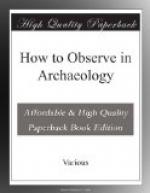Where there is writing, or the relief is too faint to squeeze, put the paper immediately below the first line, and draw it sign for sign, so that the spacing is preserved and no omission is possible. Fold back the paper as each line is copied, and so always keep the copying close below the line of inscription.
If the signs are in an alphabet that is not familiar, refer to the table of alphabets.
Sculpture Sculpture in low relief can be copied best by dry squeeze. As the connexion of the sheets used should be exact, put up the first sheet truly vertical, and mark little pencil crosses at the corners on the stone. Then the corners of successive sheets should be fitted into the angles of the crosses. When inking in the pencil drawings, do not carry the lines within two inches of the edges of the sheets. Then place sheets edge to edge, adjust them to fit as best they may, weight them heavily with books, turn back one edge and weight it, and then slip a strip of wetted adhesive paper half-way under the edge that is down; at once liberate the edge that is up, and dab (not rub) both heavily down on the adhesive. This makes a joint free of cockling, and when dry the inking can be completed across the joint. Where there is any colour remaining on sculpture or inscription, only dry squeezing is permissible.
Where signs are worn or decayed it is needful to try various lighting. This can be done in the open air, by shading the part by the hands placed around it as a sort of tube, the head blocking out the light over the tube. Then quickly raise a hand alternately, so as to reverse the oblique lighting, and watch the effect on the sign.
If the stone has not too tender a face, careful washing often brings out an inscription; and in such cases it is usually far easier to copy from a wet than from a dry stone.
If reliefs have been much weathered they can be made plain for photographing by laying horizontal and covering with sand; on wiping away the sand from the relief the ground will be left flat sand, so hiding the confused hollows of weathering.
The safest way for drawings to travel is to post them at the nearest post direct to where they will be worked up. The Postal Union takes rolls of 21 cm. thick, 60 cm. long, up to 5 kilos as parcels, or rolls of 10 cm. thick, 75 cm. long, up to 2 kilos by book post open at ends. This is far better than carrying rolls by hand.
Wet squeezing. Where there is no colour, and the stone is strong and not crumbling, a wet squeeze is the best copy. There are three purposes for it, and the method differs for each; (1) thin single sheet kept fresh on the outer face for photographing later; or (2) single sheet well beaten in and patched, depending on pricking the outlines and hand-copy from it, or blacking over the relief on the inner side and photographing; or (3) double sheet hard beaten, and patched in the hollows, for plaster casting afterwards.




